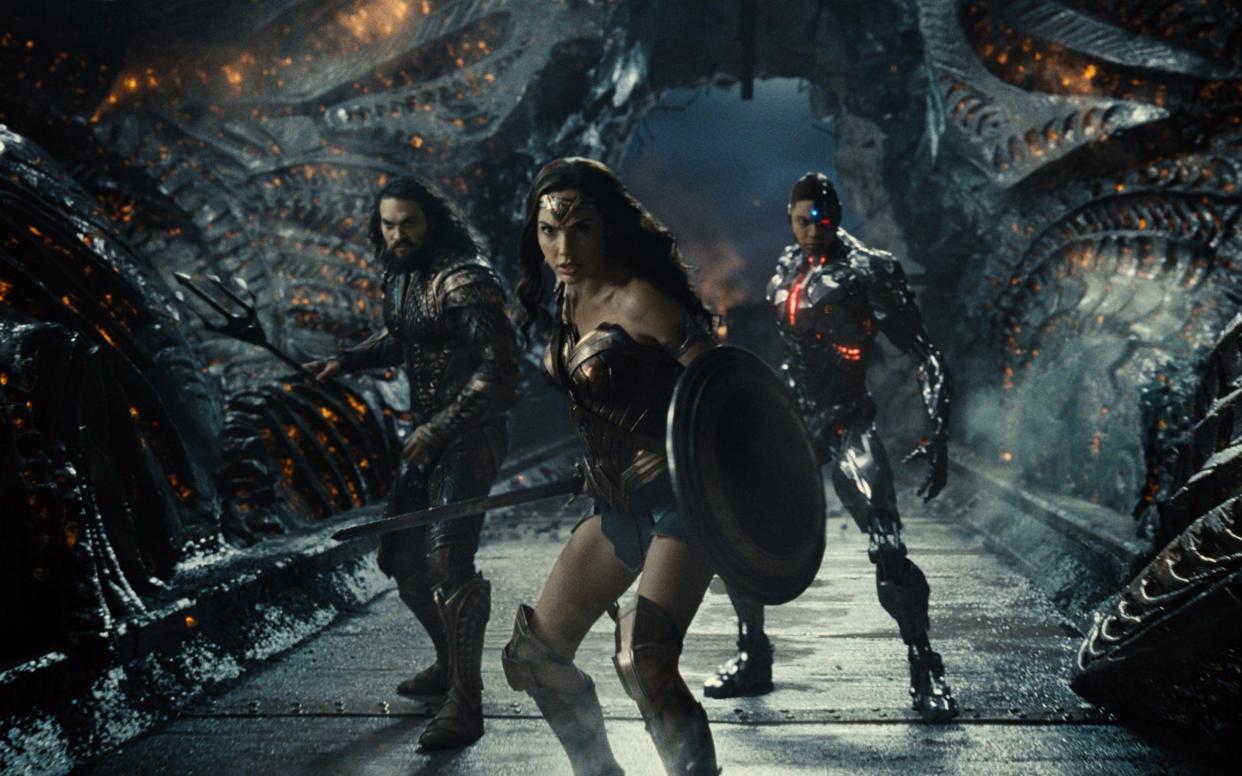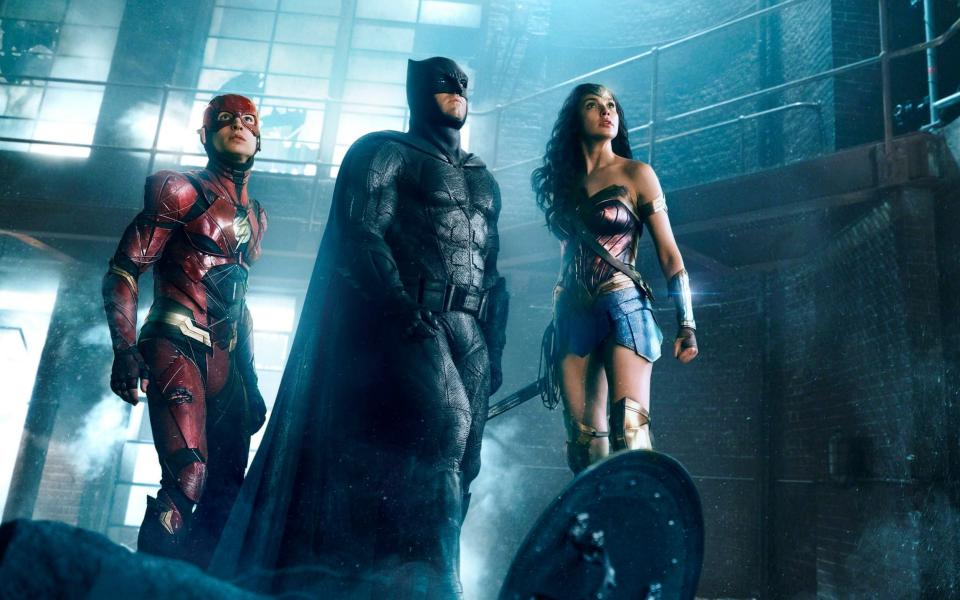Zack Snyder’s Justice League is a mad and magnificent, four-hour apocalyptic pop epic

Dir: Zack Snyder; Starring: Ben Affleck, Henry Cavill, Gal Gadot, Amy Adams, Ray Fisher, Ezra Miller, Jason Momoa, Jeremy Irons, Amber Heard, Diane Lane, JK Simmons, Jared Leto. No cert, 243 min
For as long as audiences want to see world events thwacked, socked and thunked onto a different course, the superhero film will continue to thrive. In the unsteady 21st century, progressive empowerment fantasies are big business, as the £16 billion and counting spent on Marvel movies at the global box office attests.
But alongside the dream of watching a witty, friendly, painstakingly inclusive gang of pals righting wrongs on our behalf, a countervailing fantasy exists – one of pure, exhilarating helplessness, in which we’re given ringside seats to a brawl between gods, and all we can do is watch them slug it out while praying we don’t get toasted in the process.
This has, perhaps unsurprisingly, proven a less commercially sound approach than the funny, brightly coloured super-chums. But in his aborted superhero franchise for Warner Bros, it’s what Zack Snyder was always selling. The Watchmen and 300 director’s DC Extended Universe was meant to yield at least five films, but ended up with just three: the first two of which were his chilly, mythic, 9/11-invoking Superman reboot Man of Steel, and Batman v Superman: Dawn of Justice, its poorly received and pulverisingly downbeat follow-up.
The third was Justice League, a series-capping crossover in which Henry Cavill’s Clark Kent and Ben Affleck’s Bruce Wayne were to be united with four other B-tier heroes from the DC stable, and which disintegrated mid-shoot as the studio tried to steer Snyder’s inky-black approach onto cuddlier, Marvellian turf. (Snyder eventually departed the project amid personal tragedy, and directing duties were assumed by Marvel alumnus Joss Whedon.) The two-hour film scratched together from the wreckage was almost unwatchable, though diehard fans maintained that if only Snyder had been allowed free rein with the material, an era-defining masterpiece might have resulted.
Surprise! Against the odds, they were essentially right. With a new streaming platform to plug, Warner Bros has spent a further $70 million on a second version of Justice League, constructed by Snyder in line with his original vision for the project. And the result – a mad and magnificent, four-hour apocalyptic pop epic – feels like the last word on Hollywood’s comic-book blockbuster phase, however many more years the industry manages to wring out of it.
It shares a vague shape and a handful of specific, linchpin scenes with its predecessor, but everything about it lands differently: characters that were previously empty or ludicrous now have real grit and depth, while action sequences that were once incoherent, lightweight and garish now number among the most thunderously spectacular in the genre.
The film is split into six sections plus an epilogue, but essentially divides cleanly in two. It begins with the death of Cavill’s Superman: this was the widely anticipated twist ending of Batman v Superman, but is restaged here to show the Kryptonian’s death rattle as a kind of cosmic signal that Earth is ripe for the conquering. This catches the ear of Steppenwolf (Ciarán Hinds), a hideous horned demon with a suit of armour that makes him look like a sentient cutlery drawer, and his even larger and more hideous master Darkseid (Ray Porter), a sort of goth take on Marvel’s Thanos, who speaks in a ground-splitting growl and could have lumbered directly out of the pages of Heavy Metal magazine.

Its first half – heavy on flashbacks – charts the formation of the League itself, with Affleck’s Batman and Gal Gadot’s Wonder Woman doing their best to persuade Ezra Miller’s Flash, Jason Momoa’s Aquaman and Ray Fisher’s Cyborg to join up for the coming fight. All five benefit enormously from the expanded running time, and Affleck’s world-weary take on Batman is redeemed at a stroke – a very long stroke, in fairness.
But it’s Fisher’s Victor Stone who gains the most: a character that didn’t previously amount to anything more than a grumpy robot is now a troubled young man semi-estranged from the father whose technological implants afford him an übermenschean command over the digital realm.
Meanwhile, Steppenwolf and his skeletal henchmen hunt for the three ancient artefacts that will summon Darkseid to the party, and transform the planet into a blasted, Boschian hellscape – and the struggle to prevent them doing so makes up the outrageously overblown yet never less than uproariously enjoyable sturm und drang of its second half.
Hero worship has always been Snyder’s strong suit. Even in his 2010 film Legend of the Guardians – a family-friendly animation about the adventures of a fluffy young owl – his visual style has always tended towards the fascistic, with stark, towering compositions designed to make us puny audience members shrink in awe, and frequent use of slow-motion to allow us to goggle at his protagonists’ superhuman (or super-avian) feats.

In Justice League, such spectator-squashing techniques are out in force: with Gadot’s Wonder Woman, who could be a cousin of Gerard Butler’s beefcake Spartan chieftain from 300, there is always a jolt of pure excitement that shoots through the frame in the split second before she launches herself into combat, as if the film is warning you to hold onto your seat.
This is thanks in part to Tom Holkenborg’s surging, Hans Zimmer-esque score, which expertly marshals the flow of energy in battle scenes: though the film will be released this week on streaming platforms, it belongs in a crowded IMAX auditorium, and will hopefully screen in some before the year is out.
For those unsold so far on the Snyder approach to super-heroism, or super-heroic cinema in general, Justice League doesn’t feel like the film to tip the balance in its favour. But in a genre increasingly hidebound by formula, it stands as a monument to exceptionalism that itself feels exceptional.
On Sky Cinema and Now TV from Thursday 18 March


